Being behind in a number of areas, it's hard to get back into the swing of writing for the blog, especially because a number of draft entries in my head will take hours and hours to write given the depth required to fully cover the issue (such as reconsidering disaster planning in the wake of Superstorm Sandy and the impact on New York City, the latest plans for "managing the demise" of the DC Public Schools, the changing of the editor in chief of the
Washington Post and its coverage of local issues).
Below is a reprint of a blog entry from last year, but what makes it no less relevant today:
• is how a couple months back, Portland expanded streetcar service to the Eastside ("
Eastside streetcar: Carrying the wait" from the
Portland Business Journal); according to the story, the new line has about 3,200 daily riders, while the initial ridership on the first streetcar line was about 5,900, but that serves downtown as well
• Seattle continues to plan for streetcar expansion, although I was surprised to learn that so far the service has fewer than 3,000 daily riders. I have already written about how Amazon has proffered a lot of money including paying for another streetcar and service increases to support its application for new development ("
Monetizing community benefits for public space conversion and other considerations: Seattle");
• in a very interesting development and a rush job, New Orleans is building a new streetcar line to serve the Superdome because it will be the home of the Super Bowl in February and they want to provide better transit options to get there ("
New Orleans streetcar line to get Super Bowl debut," Associated Press). I think that's interesting because one of the complaints that arose in Indianapolis earlier this year with regard to the Superbowl was the lack of mobility options (taxi, transit) for visitors ("
Super Bowl scene: Good luck hailing a cab in Indianapolis" from the
Newark Star-Ledger). There is some controversy over the line due to its routing, but I think it's very impressive that they're pulling off this expansion on such a short time frame, given the interminable process in DC.
• plus Virginia Beach voters in favor of light rail in referendum earlier in the month ("
Light rail passes easily in Virginia Beach" from the
Norfolk Virginian-Pilot), in the face of an opposition campaign run by various municipal workers unions, who see light rail as competing for funds within the city budget.
• I just don't have the heart to write much about the Keystone Cops like adventure of getting streetcar service in DC, as it has been about 10 years since planning for streetcars first began in the city.
------------
 Portland Streetcar at Jameson Square. Image from Portland Ground.
Portland Streetcar at Jameson Square. Image from Portland Ground. Note that an ongoing discussion on this topic with Nigel Foster helped shape this entry.
Sparked by low ridership, continued financial problems and the impeding raise in fares, in September there was a piece, "
Derail the People Mover," in the
Detroit News by Bill Johnson, calling for an end to the city's People Mover. Separately, there are initiatives to develop light rail service along Woodward Avenue, serving Detroit and Oakland County.
My reaction was that the People Mover's general failure in Detroit has masked key distinctions in thinking about transit, over two scales, (1) intra-city transit and transit's role in repositioning center cities as desirable places to live, locate businesses, and visit, versus(2) inter-city transit, that is bringing people to and from the city.
Typically, cities haven't been good proponents of intra-city transit subnetworks, especially with economic development considerations, because (1) transit is seen as a service of last resort, for people who can't afford cars; and (2) because usually transit service is provided as part of a regional service and in that context service within the center city is not necessarily prioritized, even though center city residents tend to make up the greatest proportion of riders.
Detroit had a lot of other economic revitalization problems before the People Mover was created, and in such an automobile-centric place, rebuilding the center city around transit is counterintuitive, so it's probably not a good example of how these kinds of focused transit services can help spark Downtown improvement, but it led me to begin thinking about a typology of these kinds of intra-city transit services:
Bus
1. Bus transit malls--Portland, Minneapolis (Nicollet Mall), Denver
2. Circulator bus services in various iterations--the latest have modern, more comfortable buses, better branded services, and more frequent headways (DC, Baltimore)
3. Various lane priority schemes
Rail
4. People Mover type services (Detroit, Miami) [note that Nigel points out that such services within airports demonstrate that campus serving opportunities for people movers can make sense, such as for a hospital center spread out over many acres, like the medical center in Houston)
5. Monorails (earlier truncated line in Seattle, more modern service in Las Vegas, Singapore, Kuala Lumpur and other systems in Asia--Nigel, being in New Zealand, has experience with these systems too, which mostly have a limited number of stations)
6. Heritage streetcar systems (McKinney Street, Dallas, Little Rock, Tampa, etc.)
7. Modern streetcar systems (Portland, Seattle, plans for Washington, DC and Arlington, Virginia and many other cities)
Similar to how bus rapid transit is being marketed, by distinguishing the circulator buses with more modern, attractive, comfortable buses versus more traditional, value engineered buses, bus service, at least in the context of circulator service (but not traditional bus service), has been repositioned as a premium service.
Images from the first Bob Firth article, which is primarily a set of illustrations explaining what a Circulator does.
Bus transit malls are good for focusing transit services and making people aware of where to go to catch the bus, but they don't always work out on placemaking considerations, given the noise and exhaust and dominance of the streetscape by many large vehicles. This wasn't helped by early iterations which had "heavy" bus shelters which also overwhelmed the streetscape.
Top photo: Nicollet Transit Mall, Minneapolis. Photo by Jerry Holt of the Minneapolis Star Tribune. Bottom photo: Old Portland bus mall shelters. Flickr photo by Jason McNuff.
Focused transit services downtown often start with transit malls, which serve both intra-city and inter-city functions. Circulator bus systems are the next generation of this kind of service, more focused on intra-city service, and a lot cheaper to implement than streetcars.
The question remains however on whether or not bus-based Circulator systems can spark economic development the way that fixed rail transit does. It will be interesting to see how this works in Baltimore as opposed to DC, where it's harder to separate out the impact of subway service on economic development vs. any impact that might come from enhanced bus service.
 Top: Las Vegas Monorail photo on Flickr by Richard Pilon. Detroit People Mover photo below by cmu chem prof from Flickr.
Top: Las Vegas Monorail photo on Flickr by Richard Pilon. Detroit People Mover photo below by cmu chem prof from Flickr.
People Movers and Monorails haven't really worked out in terms of sparking economic development. The Detroit People Mover never had that much ridership, while the Miami Metromover, with 22 stations, gets more than 30,000 daily riders. The Las Vegas monorail system went through bankruptcy and the Seattle one is truncated, and the above-ground systems, while not impeded by traffic, can be a drag on the viewshed.
The Las Vegas monorail may become successful over time, because of people's desires to get between various casinos in the city--on the other hand, if people stay within their hotel-casino complexes, maybe there isn't that much demand for this kind of service. Given that roughly 2,000 people ride the the monorail daily, maybe that's the case.
Maybe the relative lack of success has to do with their being in the air, just as the skywalks in Minneapolis, while successfully moving people between buildings in bad weather, end up removing people from the street, so success comes at the expense of vitality at the street level.
Streetcars (and bus-based circulators) integrate better into the built environment than monorails and people movers, but their in-street operation creates a lot of opposition (at least by motor vehicle operators) who see the addition of streetcars as a competitor for scarce street space, even though by comparison a streetcar can carry 100 or more people in the same space as 3-5 cars.
Heritage streetcars are a variant, more focused on tourism and out-of-region visitors rather than repositioning an area within the regional landscape for residential choice and commerce. The Little Rock streetcar seems to have had more success in terms of sparking economic development than the Tampa equivalent. Likely this is due to greater focus and integration with economic development revitalization planning in Little Rock versus the planning in Tampa, which provides service to Ybor City, a major entertainment and tourist destination.
Streetcar at the River Market (a newly constructed public market which is also very successful in its own right) in Little Rock, Arkansas. Flickr photo by Skyline Scenes.
Articles about streetcars in Portland and Seattle and how they respectively helped focus redevelopment of the Pearl District in Portland and the South Lake Union district in Seattle, supporting billions of dollars of economic development, are numerous. The experiences there demonstrate that when intra-city transit systems are developed in a purposeful way to promote economic development, placemaking, and the repositioning of the center city as a residential and business location of choice, they can have incredible return on investment.
--
Understanding the Impacts of Transitways The Hiawatha Line: Impacts on Land Use and Residential Housing Value, Center for Transportation Studies, University of Minnesota,
research brief,
full document
The typology is important because there are so many plans for streetcars around the country, in various stages of development, including cities like Cincinnati, New Haven, San Antonio, Baltimore, Oakland, Atlanta, Los Angeles, etc. that it's almost impossible to keep track of all of them.
But because so many people, especially elected officials, see transit as a service of last resort, not as a positive force that supports a more sustainable, urban lifestyle where transit, rather than automobility, complemented by walking and/or bicycling, is the primary means for getting around the city, getting forward movement on such systems--despite the successes in Portland and Seattle--is very difficult.
Even though New York City has typified a transit-centric lifestyle and mobility paradigm for many years, many people have a hard time grasping that it is possible in a country that has prioritized automobility for the past 90 years.
Even so, Washington, DC and the Wilson Boulevard corridor in Arlington County, Virginia, as well as the areas served by the streetcar in Portland (Nob Hill, Pearl District, Downtown) show that this kind of pro-urban lifestyle is exportable to more places in the U.S. than previously thought.
But it's still a struggle (even in places like Washington and Arlington, which are part of a region where the subway--heavy rail transit--is very successful).
While in Detroit they aren't thinking about what else needs to be done in order to refocus development around transit and downtown, New Haven provides another example of disconnects over planning for the long term.
Labels: transit and economic development, transportation planning, urban design/placemaking, urban revitalization
 Portland Streetcar at Jameson Square. Image from Portland Ground. Note that an ongoing discussion on this topic with Nigel Foster helped shape this entry.
Portland Streetcar at Jameson Square. Image from Portland Ground. Note that an ongoing discussion on this topic with Nigel Foster helped shape this entry.


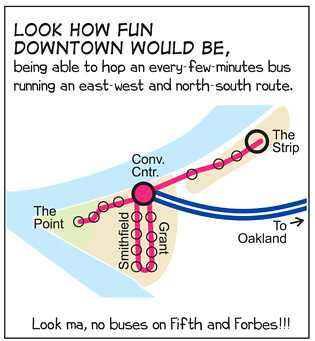
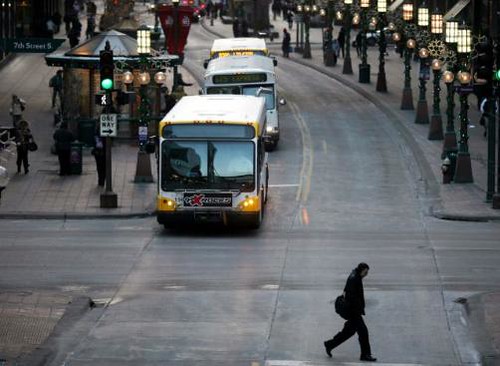
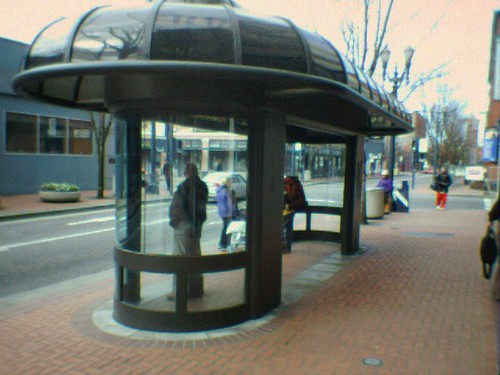
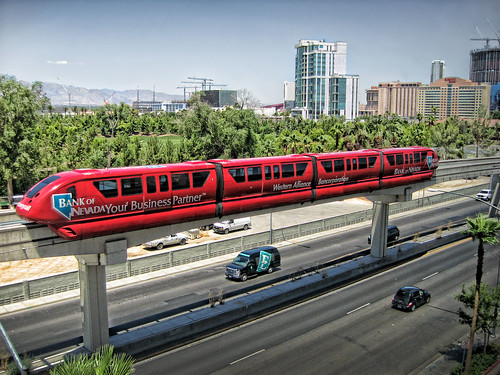
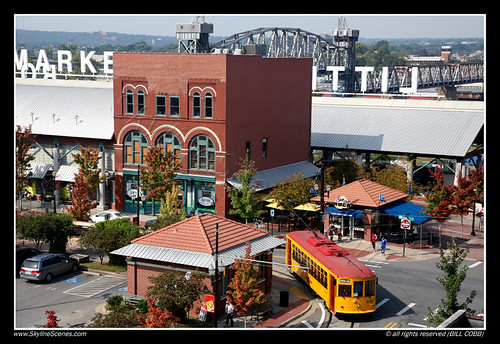



8 Comments:
Interesting, comprehensive piece. A minor quibble:
1) The N.O. streetcar is timed to start running around the Super Bowl, but it ties in to the Amtrak and Greyhound station and the larger network.
I do think the Denver bus system on 16th st was very impressive. Integrated, had its own lane and just was a natural, free, way to get around. I take buses 10x as much as rail, but still understand the pro-rail folks. That bus in Denver felt different though.
I still haven't made it to Colorado/Denver and yes, I definitely do want to check out that bus mall as well as other developments there. (Earlier in the year I did meet a high level RTA official.)
Thanks for adding that point about New Orleans.
I should have mentioned it, because obviously, plans for expansion of the streetcar system date to 2009 grant requests, and planning that began earlier, that it is impressive that they used the coming of the Superbowl to extend their transit infrastructure in a manner that has multiple benefits beyond the one week of the superbowl--those broader connections that you point out the streetcar extension will enable.
Indianapolis is interesting as a counterpoint. It's such a car-centric place that maybe they could have done a streetcar loop within downtown, but it wouldn't have that much long term impact, because of the nature of visitorship to the city, plus the reality that it will take a long time to repattern Indy mobility practices toward transit.
OTOH, had they built a streetcar loop, it would have made a big difference long term for the city and the downtown, vis a vis the suburbs.
However, and another weird knock against city-county mergers, is that apparently the Growth Machine in Indy/Marion County is suburban centric and uses their power to keep things that way, although yes there continues to be investment downtown, and there is greater clamor for more robust transit.
So I guess a streetcar would have been a good thing (like the Pearl District in Portland), and more Mayors ought to keep that idea in their back pocket for when the Super Bowl comes calling.
That's a great larger point you just made. Its almost like the World Cup - infrastructure improvements (with a heavy focus on transit improvements) are key to being granted the ability to host the event.
The Super Bowl could adopt something similar requirement wise and make more of a lasting impact on the host cities. Interesting idea, although the NFL doesn't seem particularly transit friendly (see their plans for having the LA stadium in a non transit accessible spot rather than downtown where the city wants it).
yep. good points. To make this happen there would need to be requirements at a higher level (imposed on cities by states e.g.) where stadiums, arenas, and major special events like the Super Bowl would have to be located in places well served by transit.
But that doesn't necessarily mean in-city locations (Madison Sq. Garden, now Barclays Arena, Verizon Center, Nationals Stadium, Wrigley Field, Fenway Park) that are very urban and integrated into the city.
I've never been to Yankee Stadium, but the Mets stadium has good transit connections (subway and railroad, actually for both stations). But in either case, they don't have the same impact that the sports arenas do in the other cases.
Check out one of my first blog entries, on this topic, when the Nationals stadium was first being discussed.
If you click on the image boxes, images will still display.
http://urbanplacesandspaces.blogspot.com/2005/07/tale-of-two-or-more-cities.html
Oh, and this old entry is also on that same general point, about the district around a stadium or arena being about more than just the stadium, using LoDo in Denver (again, I've never been, although there is also a great chapter on LoDo in the book _Cities: Back from the Edge_).
http://urbanplacesandspaces.blogspot.com/2005/03/denvers-delightful-lodo-area-lesson.html
Sorry, the reason that I say such requirements have to be imposed is that local jurisdictions will always come up with reasons to puncture their own laws, if that's what the sports team wants.
Thank you for giving us insights and inspirations. This article is really helpful and informative. We would like to see more updates from you in the future.
Best Trading Books
It has been very useful, I was looking for something similar,greetings and thanks.click it...: ed pills online
nice information.Much obliged to you for giving such essential data, and a debt of gratitude is for sharing this issue.
Post a Comment
<< Home